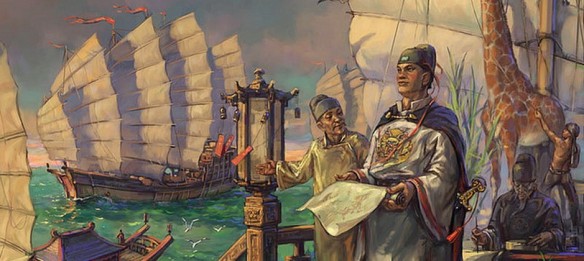
China’s emergence as a powerful maritime entity is, in fact, a re-emergence. Decades before the explorations of Columbus, 15th century Admiral Zheng He commanded the largest wooden ships in history on far-ranging voyages for the greater glory of Ming emperors.
Historians have exaggerated Chinese neglect of the sea. The Southern Song Dynasty (1127–1279) had Hangzhou, a seaport on the Yangtze River, as its capital. Large shipyards supported a significant naval force, which the Mongols inherited when their Yuan Dynasty (1271–1368) overthrew the Song. The Mongols launched (albeit unsuccessfully) the largest amphibious operations of the Middle Ages—against Japan, Vietnam, and Java. In the 1300s, the Chinese made cutting-edge innovations in shipbuilding and naval armaments, and invented the magnetic compass.
The Ming Dynasty had a strong naval element from start to finish. It first established itself by defeating its rivals in southern China largely through the use of naval power. Larger than all but a few sea battles in history, the decisive battle of Lake Poyang in 1363 involved hundreds of warships on both sides.
The peak of Ming maritime accomplishment came with the seven voyages of eunuch admiral Zheng He (1405–33). Supported by Emperor Yongle, Zheng commanded expeditions of hundreds of ships and tens of thousands of men on history’s largest wooden ships, some perhaps more than 440 feet long and displacing 20,000 tons. These voyages nurtured trade, (re)opened relations with tributary kingdoms, demonstrated hard and soft power, and brought the Ming flag through the Strait of Malacca across the Indian Ocean to the Persian Gulf and East Africa. But Zheng’s costly voyages brought few tangible benefits to the empire, the imperial bureaucracy opposed them as risky and wasteful, and he made just one voyage after Emperor Yongle’s death.
In the 1500s, harsh but unevenly enforced imperial edicts discouraged long-distance maritime commerce and drove Chinese and foreign merchants into piracy. Though still a formidable sea power in aggregate capabilities and trade, Ming China lost its lead in nautical technology and took years to rescind prohibitions and dissipate piracy along its own coast, which flourished during the Wokou Raids of the 1540s–80s.
Qing China’s (1644–1912) geostrategic orientation was the subject of major debate between Li Hongzhang, head of the Beiyang Navy; and Zuo Zongtang, leader of the expeditionary force to recover Xinjiang. The Qing chose land power, and both General Li and the nation suffered the consequences.
In addition to existing internal political problems, the Qing were suddenly confronted with the threat of rising British, French, and Japanese naval power in Asia. Qing China proved incapable of meeting the maritime challenge posed by the modern navies of the Western powers. In the First Opium War (1839–42), a British fleet penetrating to the heart of China’s riverine network threatened to shut down the country’s internal commerce, thus forcing the regime to sue for peace; Britain acquired Hong Kong.
The Qing eventually purchased ships from abroad but had neither the reliable infrastructure nor the professional navy to operate them effectively in battle, with disastrous results. In the 1880s, defeat of China’s nascent fleet at the hands of the French sealed the end of its traditional influence in Indochina. By the last decade of the century, in spite of their acquisition of significant naval capabilities, the Chinese proved no match for their rapidly modernizing island neighbor and suffered humiliating defeat in the Sino-Japanese War of 1894–95, leading to the loss of Taiwan and to a Japanese protectorate in Korea.
Pressed by the Russians from the north as well as by the Western maritime powers, the imperial court was forced to accede to rising demands for commercial and territorial concessions. In 1905, China suffered terribly but without recourse as the Russo-Japanese War was waged on its land territory and in nearby waters, in part over access to strategically located Port Arthur.
All of these developments would fatally weaken the foundations of the dynasty and indeed the legitimacy of the empire itself. The fall of the Qing in 1911 led to a long period of internal instability. Qing China’s maritime defeats thus stemmed from its failure to wholeheartedly embrace Western naval techniques following the first Opium War—in sharp contrast to its rival Japan.